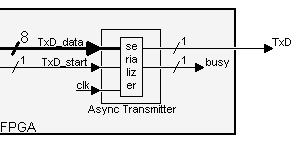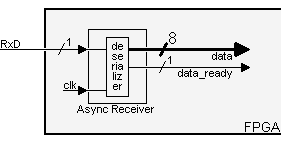将FPGA和PC连接的最简单的方式就是通过一个串行接口,我们只需要一个发送器和一个接收器模块。
异步发送器
异步接收器
RS-232串行接口是如何工作的
An RS-232 interface has the following characteristics:
- Uses a 9 pins connector “DB-9” (older PCs use 25 pins “DB-25”).
- Allows bidirectional full-duplex communication (the PC can send and receive data at the same time).
- Can communicate at a maximum speed of roughly 10KBytes/s.
DB-9连接器
You probably already saw this connector on the back of your PC.

It has 9 pins, but the 3 important ones are:
- pin 2: RxD (receive data).
- pin 3: TxD (transmit data).
- pin 5: GND (ground).
Using just 3 wires, you can send and receive data.
Data is commonly sent by chunks of 8 bits (we call that a byte) and is “serialized”: the LSB (data bit 0) is sent first, then bit 1, … and the MSB (bit 7) last.
异步通信
接口采用异步协议,这意味着在数据传输的同时没有时钟信号,接收端就得从进来的数据比特中提取出时钟信息。
在RS-232中,它是如此处理的:
- Both side of the cable agree in advance on the communication parameters (speed, format…). That's done manually before communication starts.
- The transmitter sends “idle” (=“1”) when and as long as the line is idle.
- The transmitter sends “start” (=“0”) before each byte transmitted, so that the receiver can figure out that a byte is coming.
- The 8 bits of the byte data are sent.
- The transmitter sends “stop” (=“1”) after each byte.
Let's see how looks the byte 0x55 when transmitted:

Byte 0x55 is 01010101 in binary.
But since it is transmitted LSB (bit-0) first, the line toggles like that: 1-0-1-0-1-0-1-0.
Here the data is 0xC4, can you see it? The bits are harder to see. That illustrates how important it is for the receiver to know at which speed the data is sent.
数据能发送多块?
The speed is specified in baud, i.e. how many bits-per-seconds can be sent. For example, 1000 bauds would mean 1000 bits-per-seconds, or that each bit lasts one millisecond.
Common implementations of the RS-232 interface (like the one used in PCs) don't allow just any speed to be used. If you want to use 123456 bauds, you're out of luck. You have to settle to some “standard” speed. Common values are:
- 1200 bauds.
- 9600 bauds.
- 38400 bauds.
- 115200 bauds (usually the fastest you can go).
At 115200 bauds, each bit lasts (1/115200) = 8.7µs. If you transmit 8-bits data, that lasts 8 x 8.7µs = 69µs. But each byte requires an extra start and stop bit, so you actually need 10 x 8.7µs = 87µs. That translates to a maximum speed of 11.5KBytes per second.
At 115200 bauds, some PCs with buggy chips require a “long” stop bit (1.5 or 2 bits long…) which make the maximum speed drop to around 10.5KBytes per second.
物理层
The signals on the wires use a positive/negative voltage scheme.
- “1” is sent using -10V (or between -5V and -15V).
- “0” is sent using +10V (or between 5V and 15V).
So an idle line carries something like -10V.
资源链接
- 一个简短的关于异步通信的页面
波特率发生器
Here we want to use the serial link at maximum speed, i.e. 115200 bauds (slower speeds would also be easy to generate). FPGAs usually run at MHz speeds, well above 115200Hz (RS-232 is pretty slow by today's standards). We need to find a way to generate (from the FPGA clock) a “tick” as close as possible to 115200 times a second.
Traditionally, RS-232 chips use a 1.8432MHz clock, because that makes generating the standard baud frequencies very easy… 1.8432MHz divided by 16 gives 115200Hz.
// let's assume the FPGA clock signal runs at 1.8432MHz // we create a 4-bit counter reg [3:0] BaudDivCnt; always @(posedge clk) BaudDivCnt <= BaudDivCnt + 1; // count forever from 0 to 15 // and a tick signal that is asserted once every 16 clocks (so 115200 times a second) wire BaudTick = (BaudDivCnt==15);
That was easy. But what do you do if instead of 1.8432MHz, you have a 2MHz clock? To generate 115200Hz from a 2MHz clock, we need to divide the clock by “17.361111111…” Not exactly a round number. The solution is to divide sometimes by 17, sometimes by 18, making sure the ratio stays “17.361111111”. That's actually easy to do.
Look at the following “C” code:
while(1) // repeat forever { acc += 115200; if(acc>=2000000) printf("*"); else printf(" "); acc %= 2000000; }
That prints the “*” in the exact ratio, once every “17.361111111…” loops on average.
To obtain the same thing efficiently in an FPGA, we rely on the fact that the serial interface can tolerate a few % of error in the baud frequency generator.
It is desirable that the 2000000 be a power of two. Obviously 2000000 is not. So we change the ratio… Instead of “2000000/115200”, let's use “1024/59” = 17.356. That's very close to our ideal ratio, and makes an efficient FPGA implementation: we use a 10-bit accumulator incremented by 59, with a tick marked everytime the accumulator overflows.
// let's assume the FPGA clock signal runs at 2.0000MHz // we use a 10-bit accumulator plus an extra bit for the accumulator carry-out reg [10:0] acc; // 11 bits total! // add 59 to the accumulator at each clock always @(posedge clk) acc <= acc[9:0] + 59; // use 10 bits from the previous accumulator result, but save the full 11 bits result wire BaudTick = acc[10]; // so that the 11th bit is the accumulator carry-out
Using our 2MHz clock, “BaudTick” is asserted 115234 times a second, a 0.03% error from the ideal 115200.
Parameterized FPGA baud generator
The previous design was using a 10 bits accumulator, but as the clock frequency increases, more bits are required.
Here's a design with a 25MHz clock and a 16 bits accumulator. The design is parameterized, so easy to customize.
parameter ClkFrequency = 25000000; // 25MHz parameter Baud = 115200; parameter BaudGeneratorAccWidth = 16; parameter BaudGeneratorInc = (Baud<<BaudGeneratorAccWidth)/ClkFrequency; reg [BaudGeneratorAccWidth:0] BaudGeneratorAcc; always @(posedge clk) BaudGeneratorAcc <= BaudGeneratorAcc[BaudGeneratorAccWidth-1:0] + BaudGeneratorInc; wire BaudTick = BaudGeneratorAcc[BaudGeneratorAccWidth];
One last implementation issue: the “BaudGeneratorInc” calculation is wrong, due to the fact that Verilog uses 32 bits intermediate results, and the calculation exceeds that. Change the line as follow for a workaround.
parameter BaudGeneratorInc = ((Baud<<(BaudGeneratorAccWidth-4))+(ClkFrequency>>5))/(ClkFrequency>>4);
This line has also the added advantage to round the result instead of truncating.
Now that we have a precise enough Baud generator, we can go ahead with the RS-232 transmitter and receiver modules.
发送器
We are building an “async transmitter” with fixed parameters: 8 data bits, 2 stop bits, no-parity.

It works like that:
- The transmitter takes an 8-bits data inside the FPGA and serializes it (starting when the “TxDstart” signal is asserted). * The “busy” signal is asserted while a transmission occurs (the “TxDstart” signal is ignored during that time).
Serializing the data
To go through the start bit, the 8 data bits, and the stop bits, a state machine seems appropriate.
reg [3:0] state; // the state machine starts when "TxD_start" is asserted, but advances when "BaudTick" is asserted (115200 times a second) always @(posedge clk) case(state) 4'b0000: if(TxD_start) state <= 4'b0100; 4'b0100: if(BaudTick) state <= 4'b1000; // start 4'b1000: if(BaudTick) state <= 4'b1001; // bit 0 4'b1001: if(BaudTick) state <= 4'b1010; // bit 1 4'b1010: if(BaudTick) state <= 4'b1011; // bit 2 4'b1011: if(BaudTick) state <= 4'b1100; // bit 3 4'b1100: if(BaudTick) state <= 4'b1101; // bit 4 4'b1101: if(BaudTick) state <= 4'b1110; // bit 5 4'b1110: if(BaudTick) state <= 4'b1111; // bit 6 4'b1111: if(BaudTick) state <= 4'b0001; // bit 7 4'b0001: if(BaudTick) state <= 4'b0010; // stop1 4'b0010: if(BaudTick) state <= 4'b0000; // stop2 default: if(BaudTick) state <= 4'b0000; endcase
Now, we just need to generate the “TxD” output.
reg muxbit; always @(state[2:0]) case(state[2:0]) 0: muxbit <= TxD_data[0]; 1: muxbit <= TxD_data[1]; 2: muxbit <= TxD_data[2]; 3: muxbit <= TxD_data[3]; 4: muxbit <= TxD_data[4]; 5: muxbit <= TxD_data[5]; 6: muxbit <= TxD_data[6]; 7: muxbit <= TxD_data[7]; endcase // combine start, data, and stop bits together assign TxD = (state<4) | (state[3] & muxbit);
接收器
We are building an “async receiver”:
Our implementation works like that:
- The module assembles data from the RxD line as it comes.
- As a byte is being received, it appears on the “data” bus. Once a complete byte has been received, “data_ready” is asserted for one clock.
Note that “data” is valid only when “data_ready” is asserted. The rest of the time, don't use it as new data may come that shuffles it.
Oversampling
An asynchronous receiver has to somehow get in-sync with the incoming signal (it normally doesn't have access to the clock used by the transmitter).
To determine when a new data byte is coming, we look for the “start” bit by oversampling the signal at a multiple of the baud rate frequency. Once the “start” bit is detected, we sample the line at the known baud rate to acquire the data bits. Receivers typically oversample the incoming signal at 16 times the baud rate. We use 8 times here… For 115200 bauds, that gives a sampling rate of 921600Hz.
Let's assume that we have a “Baud8Tick” signal available, asserted 921600 times a second.
The design
First, the incoming “RxD” signal has no relationship with our clock. We use two D flip-flops to oversample it, and synchronize it to our clock domain.
reg [1:0] RxD_sync; always @(posedge clk) if(Baud8Tick) RxD_sync <= {RxD_sync[0], RxD};
We filter the data, so that short spikes on the RxD line aren't mistaken with start bits.
reg [1:0] RxD_cnt; reg RxD_bit; always @(posedge clk) if(Baud8Tick) begin if(RxD_sync[1] && RxD_cnt!=2'b11) RxD_cnt <= RxD_cnt + 1; else if(~RxD_sync[1] && RxD_cnt!=2'b00) RxD_cnt <= RxD_cnt - 1; if(RxD_cnt==2'b00) RxD_bit <= 0; else if(RxD_cnt==2'b11) RxD_bit <= 1; end
A state machine allows us to go through each bit received, once a “start” is detected.
reg [3:0] state; always @(posedge clk) if(Baud8Tick) case(state) 4'b0000: if(~RxD_bit) state <= 4'b1000; // start bit found? 4'b1000: if(next_bit) state <= 4'b1001; // bit 0 4'b1001: if(next_bit) state <= 4'b1010; // bit 1 4'b1010: if(next_bit) state <= 4'b1011; // bit 2 4'b1011: if(next_bit) state <= 4'b1100; // bit 3 4'b1100: if(next_bit) state <= 4'b1101; // bit 4 4'b1101: if(next_bit) state <= 4'b1110; // bit 5 4'b1110: if(next_bit) state <= 4'b1111; // bit 6 4'b1111: if(next_bit) state <= 4'b0001; // bit 7 4'b0001: if(next_bit) state <= 4'b0000; // stop bit default: state <= 4'b0000; endcase
Notice that we used a “nextbit” signal, to go from bit to bit. <code verilog> reg [2:0] bitspacing;
always @(posedge clk) if(state==0)
bit_spacing <= 0;
else if(Baud8Tick)
bit_spacing <= bit_spacing + 1;
wire nextbit = (bitspacing==7); Finally a shift register collects the data bits as they come.
reg [7:0] RxDdata; always @(posedge clk) if(Baud8Tick && nextbit && state[3]) RxDdata ⇐ {RxDbit, RxD_data[7:1]}; </code>
应用案例
This design allows controlling a few FPGA pins from your PC (through your PC's serial port).
- It create 8 outputs on the FPGA (port named “GPout”). GPout is updated by any character that the FPGA receives.
- Also 8 inputs on the FPGA (port named “GPin”). GPin is transmitted every time the FPGA receives a character.
The GP outputs can be used to control anything remotely from your PC, might be LEDs or a coffee machine…
module serialGPIO( input clk, input RxD, output TxD, output reg [7:0] GPout, // general purpose outputs input [7:0] GPin // general purpose inputs ); wire RxD_data_ready; wire [7:0] RxD_data; async_receiver RX(.clk(clk), .RxD(RxD), .RxD_data_ready(RxD_data_ready), .RxD_data(RxD_data)); always @(posedge clk) if(RxD_data_ready) GPout <= RxD_data; async_transmitter TX(.clk(clk), .TxD(TxD), .TxD_start(RxD_data_ready), .TxD_data(GPin)); endmodule
Remember to grab the asyncreceiver and asynctransmitter modules here, and to update the clock frequency values inside.

